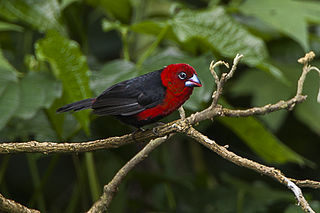
The Chamaesaura, also known as grass lizards, are a genus of legless lizards from southern and eastern Africa. The limbs are reduced to small spikes. Chamaesaura propel themselves like snakes, pushing against contact points in the environment, such as rocks, plants and irregularities in the soil. They are viviparous and eat small invertebrates, especially grasshoppers.

Trichosanthes cucumerina is a tropical or subtropical vine. Its variety T. cucumerina var. anguina raised for its strikingly long fruit. In Asia, it is eaten immature as a vegetable much like the summer squash and in Africa, the reddish pulp of mature snake gourd is used as an economical substitute for tomato. Common names for the cultivated variety include snake gourd, serpent gourd, chichindapadwal and Snake Tomato.

An ear is the grain-bearing tip part of the stem of a cereal plant, such as wheat or maize (corn). It can also refer to "a prominent lobe in some leaves."

Grant's bluebill is a species of estrildid finch found in forests in central Africa in subtropical forests or in moist lowlands. It has an estimated global extent of occurrence of 350,000 km2.

The western bluebill is a common species of estrildid finch found in Africa. It has an estimated global extent of occurrence of 1,900,000 km2.

The red-headed bluebill is a common species of estrildid finch found in Sub-Saharan Africa.
Anguina funesta is a plant pathogenic nematode.

Anguina agrostis is a plant pathogenic nematode.

Anguina is a genus of plant pathogenic nematodes.
Anguina amsinckiae is a plant pathogenic nematode, which attacks the weed called fiddleneck.
Anguina graminis, the fescue leaf gall nematode, is a plant pathogenic nematode.
Anguina australis is a plant pathogenic nematode, who is a vector for Rathayibacter toxicus in Ehrharta longiflora.
Anguina balsamophila is a plant pathogenic nematode in mules ear.

The bluebills are the genus Spermophaga of the estrildid finches family. These birds are found in tropical Africa. They are gregarious seed eaters with short, thick, blue and red bills. All have plumage which is mainly crimson and black or dark grey.

Sugarcane or sugar cane is a species of tall, perennial grass that is used for sugar production. The plants are 2–6 m (6–20 ft) tall with stout, jointed, fibrous stalks that are rich in sucrose, which accumulates in the stalk internodes. Sugarcanes belong to the grass family, Poaceae, an economically important flowering plant family that includes maize, wheat, rice, and sorghum, and many forage crops. It is native to the warm temperate and tropical regions of India, Southeast Asia, and New Guinea. Grown in tropical and subtropical regions, sugarcane is the world's largest crop by production quantity, totaling 1.9 billion tonnes in 2020, with Brazil accounting for 40% of the world total. Sugarcane accounts for 79% of sugar produced globally. About 70% of the sugar produced comes from Saccharum officinarum and its hybrids. All sugarcane species can interbreed, and the major commercial cultivars are complex hybrids.

The Cape grass lizard, also known as the Cape snake lizard or the highland grass lizard, is a species of lizard in the genus Chamaesaura. It widely found in southern Africa, inhabiting grasslands. In one of the countries it lives in, Eswatini, it is listed as a Near Threatened species.

Dasylophia anguina, the black-spotted prominent, is a species of moth in the family Notodontidae. It is native to North America.
Lacinipolia anguina, the snaky arches, is a species of cutworm or dart moth in the family Noctuidae. It is found in North America.

Riopa anguina is a species of skink found in Myanmar and Thailand.









